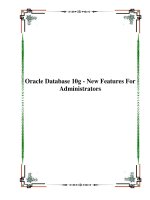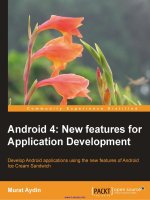android 4 new features for application development aydin 2012 12 24 Lập trình android
Bạn đang xem bản rút gọn của tài liệu. Xem và tải ngay bản đầy đủ của tài liệu tại đây (2.33 MB, 166 trang )
CuuDuongThanCong.com
www.it-ebooks.info
Android 4: New features for
Application Development
Develop Android applications using the new
features of Android Ice Cream Sandwich
Murat Aydin
BIRMINGHAM - MUMBAI
CuuDuongThanCong.com
www.it-ebooks.info
Android 4: New features for Application Development
Copyright © 2012 Packt Publishing
All rights reserved. No part of this book may be reproduced, stored in a retrieval
system, or transmitted in any form or by any means, without the prior written
permission of the publisher, except in the case of brief quotations embedded in
critical articles or reviews.
Every effort has been made in the preparation of this book to ensure the accuracy
of the information presented. However, the information contained in this book is
sold without warranty, either express or implied. Neither the author, nor Packt
Publishing, and its dealers and distributors will be held liable for any damages
caused or alleged to be caused directly or indirectly by this book.
Packt Publishing has endeavored to provide trademark information about all of the
companies and products mentioned in this book by the appropriate use of capitals.
However, Packt Publishing cannot guarantee the accuracy of this information.
First published: December 2012
Production Reference: 1171212
Published by Packt Publishing Ltd.
Livery Place
35 Livery Street
Birmingham B3 2PB, UK..
ISBN 978-1-84951-952-6
www.packtpub.com
Cover Image by Abhishek Pandey ()
CuuDuongThanCong.com
www.it-ebooks.info
Credits
Author
Project Coordinator
Murat Aydin
Esha Thakker
Reviewers
Proofreader
Rick Boyer
Maria Gould
Ahmet Oguz Mermerkaya
Nathan Schwermann
Murat Yener
Aditi Gajjar
Usha Iyer
Commissioning Editor
Maria D'souza
Yogesh Dalvi
Monica Ajmera Mehta
Graphics
Acquisition Editor
Meeta Rajani
Indexer
Production Coordinator
Prachali Bhiwandkar
Cover Work
Prachali Bhiwandkar
Technical Editor
Nitee Shetty
CuuDuongThanCong.com
www.it-ebooks.info
About the Author
Murat Aydin is a Senior Software Engineer in a company that develops software
technologies for defense systems, and an enthusiastic Android developer. He has
several Android applications in Google Play. He is a Sun Certified Java Developer
and has eight years of experience in developing web-based applications using Java
technologies, desktop, and engineering applications using .NET technologies.
He earned his BSc degree in Computer Engineering from METU (Middle East
Technical University) and his MSc degree in Software Engineering from METU.
He is a member of GDG Ankara (Google Developer Group Ankara, www.gdgankara.
org). They organize several Android events in GDG Ankara such as Android
Developer Days (www.androiddeveloperdays.com).
He is married and lives in Ankara with his wife Ülkü.
You can get in touch with him on Linkedin at />murat-ayd%C4%B1n/33/702/6a2, or through his Twitter handle @maydintr, or you
can also e-mail him at
I would like to thank my precious wife Ülkü for abiding with me
during my long hours of work for this book. A special thanks to
my parents and my siblings for supporting me. I would also like
to thank Ahmet Oğuz Mermerkaya, Murat Yener, Rick Boyer,
and Nathan Schwermann for reviewing my book. Finally, I want
to thank the team at Packt Publishing for all their help.
CuuDuongThanCong.com
www.it-ebooks.info
About the Reviewers
Rick Boyer has over twenty years of professional programming experience,
including developing applications on Windows, Windows CE, Windows Phone,
and Android. With a passion for mobile, he now focuses exclusively on the
Android platform with his consulting business, NightSky Development. He also
runs the LinkedIn group, Published Android Developers ( />where developers discuss issues related to publishing apps to the market.
You can contact him at about.me\RickBoyer.
Ahmet Oguz Mermerkaya is an Electronics Engineer but has always worked
as a software developer. He has developed softwares on different platforms using
C, C++, Java, UML, and Web (PHP, MySQL). He also has experience in extreme
programming techniques and model-driven development. Currently, he is working
on Android application development. He is the author of Merhaba Android, a turkish
book about Android application development. He is also an active member of the
GDG community in Turkey.
Nathan Schwermann is a graduate from the University of Kansas and has been
developing applications for Android professionally for over two years. He is a strong
supporter of backward compatibility and is very familiar with both Google's support
library and its famous extension Actionbar Sherlock. He also reviewed Android 3.0
Animations, Packt Publishing.
You can contact Nathan anytime at if you would like to talk
about Android, job offers, or arrange a meet up at Google IO or other popular
Android events.
CuuDuongThanCong.com
www.it-ebooks.info
Murat Yener completed his BS and MS degree at Istanbul Technical University.
He has taken part in several projects still in use at the ITU Informatics Institute. He
has worked on Isbank's Core Banking exchange project as a J2EE developer. He has
designed and completed several projects still on the market by Muse Systems. He
has worked in TAV Airports Information Technologies as a Enterprise Java & Flex
developer. He has worked for HSBC as a project leader responsible for business
processes and rich client user interfaces. Currently he is employed at Eteration
A.S. working on several projects including Eclipse Libra Tools, GWT, and Mobile
applications (both on Android and iOS).
He is also leading the Google Technology User Group Istanbul since 2009 and is
a regular speaker at conferences such as JavaOne, EclipseCon, EclipseIst, and
GDG meetings.
I would like to thank Murat Aydin, who offered me the chance to
review his wonderful book. I would also like to thank Naci Dai for
being my mentor and providing the best work environment, Daniel
Kurka for developing mgwt, the best mobile platform I ever worked
on, and Nilay Coskun for all her support.
CuuDuongThanCong.com
www.it-ebooks.info
www.PacktPub.com
Support files, eBooks, discount offers and more
You might want to visit www.PacktPub.com for support files and downloads related
to your book.
Did you know that Packt offers eBook versions of every book published, with PDF
and ePub files available? You can upgrade to the eBook version at www.PacktPub.
com and as a print book customer, you are entitled to a discount on the eBook copy.
Get in touch with us at for more details.
At www.PacktPub.com, you can also read a collection of free technical articles, sign
up for a range of free newsletters and receive exclusive discounts and offers on Packt
books and eBooks.
Do you need instant solutions to your IT questions? PacktLib is Packt's online
digital book library. Here, you can access, read and search across Packt's entire
library of books.
Why Subscribe?
• Fully searchable across every book published by Packt
• Copy and paste, print and bookmark content
• On demand and accessible via web browser
Free Access for Packt account holders
If you have an account with Packt at www.PacktPub.com, you can use this to access
PacktLib today and view nine entirely free books. Simply use your login credentials
for immediate access.
CuuDuongThanCong.com
www.it-ebooks.info
CuuDuongThanCong.com
www.it-ebooks.info
Table of Contents
Preface
Chapter 1: Action Bar for All
Action bar
Adding an action bar
Adding an ActionProvider
Adding submenus to the ActionProvider
ShareActionProvider
Adding an action view
Using the action bar for navigation
Summary
1
7
7
9
14
19
21
24
30
35
Chapter 2: A New Layout – GridLayout
37
Chapter 3: Social APIs
53
Chapter 4: Calendar APIs
67
GridLayout
Why to use GridLayout
Adding a GridLayout
Configuring GridLayout
A new view – Space
Summary
Basics of contacts in Android
Using Social API
Device user profile
Summary
Using Calendar APIs
Creating an event
Using Intents for creating events
Adding an attendee
CuuDuongThanCong.com
www.it-ebooks.info
37
39
39
43
49
51
53
54
65
65
67
68
73
73
Table of Contents
Adding a reminder
Summary
74
76
Chapter 5: Fragments
Fragment basics
Fragment lifecycle
Creating and managing fragments
Programmatically adding a fragment
Event sharing with activity
Using multiple fragments in an activity
Types of fragments
ListFragment
DialogFragment
PreferenceFragment
WebViewFragment
Summary
77
77
78
79
85
86
87
91
91
91
96
99
104
Chapter 6: Supporting Different Screen Sizes
105
Chapter 7: Android Compatibility Package
119
Chapter 8: New Connectivity APIs – Android Beam
and Wi-Fi Direct
127
Android 4.0 supports different screen sizes
Using match_parent and wrap_content
Using dip instead of px
Omit using AbsoluteLayout
Providing different bitmap drawables for different screen densities
Providing different layouts for different screen sizes
Nine-patch
Summary
What is Android Compability Package
How to use the Android Compatibility Package
Summary
Android Beam
Beaming NdefMessages
Wi-Fi Direct
Sample Wi-Fi Direct application
Summary
Chapter 9: Multiple APK Support
This chapter is available for download at
105
107
111
113
114
115
117
118
119
120
126
127
128
133
134
143
/>Support.pdf.
[ ii ]
CuuDuongThanCong.com
www.it-ebooks.info
Table of Contents
Chapter 10: APIs with Android Jelly Bean
This chapter is available for download at
/>JellyBean.pdf.
Index
[ iii ]
CuuDuongThanCong.com
www.it-ebooks.info
145
CuuDuongThanCong.com
www.it-ebooks.info
Preface
This book is a practical and hands-on guide for developing Android applications
using new features of Android Ice Cream Sandwich (Android 4.0), with a step-by-step
approach and clearly explained sample codes. You will learn the new APIs in Android
4.0 with these sample codes.
What this book covers
Chapter 1, Action Bar for All, introduces us to the action bar and shows us how to use
and configure the action bar.
Chapter 2, A New Layout – GridLayout, introduces us to GridLayout and shows us
how to use and configure GridLayout. GridLayout is a new layout introduced with
Android Ice Cream Sandwich. This layout is an optimized layout and could be used
instead of LinearLayout and RelativeLayout.
Chapter 3, Social APIs, covers the Social APIs that were introduced with Android
Ice Cream Sandwich. This API makes it easy to integrate the social networks.
Furthermore, high resolution photos can now be used as a contact's photo after Ice
Cream Sandwich was released. This chapter shows Social API usage with examples.
Chapter 4, Calendar APIs, covers the Calendar APIs which were introduced with
Android Ice Cream Sandwich for managing calendars. Event, attendee, alert, and
reminder databases can be managed with these APIs. These APIs allow us to easily
integrate calendars with our Android applications. This chapter shows how to use
Calendar APIs with examples.
Chapter 5, Fragments, introduces us to the basics of fragments and how to use them.
Chapter 6, Supporting Different Screen Sizes, introduces us to the ways of designing
user interfaces that support different screen sizes.
CuuDuongThanCong.com
www.it-ebooks.info
Preface
Chapter 7, Android Compatibility Package, introduces us to the Android Compatibility
Package and shows us how to use it. The Android Compatibility Package is to allow
the porting of the new APIs to the older versions of the Android platform.
Chapter 8, New Connectivity APIs – Android Beam and Wi-Fi Direct, introduces us to
Android Beam, which uses the NFC hardware of the device and Wi-Fi Direct which
allows devices to connect to each other without using wireless access points. This
chapter will teach us the usage of Android Beam and Wi-Fi Direct.
Chapter 9, Multiple APK Support, introduces us to Multiple APK Support which is a
new option in Google Play (Android Market) by which multiple versions of APKs
could be uploaded for a single application.
This chapter is available for download at />default/files/downloads/Multiple_APK_Support.pdf.
Chapter 10, APIs with Android Jelly Bean, covers Android Jelly Bean and the new
APIs within it.
This chapter is available for download at />default/files/downloads/Android_JellyBean.pdf.
What you need for this book
To follow the examples in this book, the Android Development Tools should be set
up and ready. The necessary software list is as follows:
•
•
•
•
Eclipse with ADT plugin
Android SDK Tools
Android platform tools
The latest Android platform
The Operating Systems that can be used are as follows:
• Windows XP (32-bit), Vista (32- or 64-bit), or Windows 7 (32- or 64-bit)
• Mac OS X 10.5.8 or later (x86 only)
• Linux (tested on Ubuntu Linux, Lucid Lynx)
°° GNU C Library (glibc) 2.7 or later is required
°° On Ubuntu Linux, version 8.04 or later is required
°° 64-bit distributions must be capable of running 32-bit applications
[2]
CuuDuongThanCong.com
www.it-ebooks.info
Preface
The specifications for use of the Eclipse IDE is as follows:
• Eclipse 3.6.2 (Helios) or greater (Eclipse 3.5 (Galileo) is no longer supported
with the latest version of ADT)
• Eclipse JDT plugin (included in most Eclipse IDE packages)
• JDK 6 (JRE alone is not sufficient)
• Android Development Tools plugin (recommended)
Who this book is for
This book is for developers who are experienced with the Android platform, but who
may not be familiar with the new features and APIs of Android 4.0.
Android developers who want to learn about supporting multiple screen sizes and
multiple Android versions; this book is also for you.
Conventions
In this book, you will find a number of styles of text that distinguish between
different kinds of information. Here are some examples of these styles, and an
explanation of their meaning.
Code words in text are shown as follows: "Implement onCreateOptionsMenu and
onOptionsItemSelected methods."
A block of code is set as follows:
<?xml version="1.0" encoding="utf-8"?>
<menu xmlns:android=" >
</item>
<item android:id="@+id/about" android:title="About">
</item>
</menu>
[3]
CuuDuongThanCong.com
www.it-ebooks.info
Preface
When we wish to draw your attention to a particular part of a code block, the
relevant lines or items are set in bold:
@Override
public void onPrepareSubMenu(SubMenu subMenu) {
//In order to add submenus, we should override this method we
dynamically created submenus
subMenu.clear();
subMenu.add("SubItem1").setOnMenuItemClickListener(this);
subMenu.add("SubItem2").setOnMenuItemClickListener(this);
}
New terms and important words are shown in bold. Words that you see on the
screen, in menus or dialog boxes for example, appear in the text like this: "Click on
the Insert button and then click on the List button".
Warnings or important notes appear in a box like this.
Tips and tricks appear like this.
Reader feedback
Feedback from our readers is always welcome. Let us know what you think about
this book—what you liked or may have disliked. Reader feedback is important for
us to develop titles that you really get the most out of.
To send us general feedback, simply send an e-mail to ,
and mention the book title via the subject of your message.
If there is a topic that you have expertise in and you are interested in either writing
or contributing to a book, see our author guide on www.packtpub.com/authors.
Customer support
Now that you are the proud owner of a Packt book, we have a number of things to
help you to get the most from your purchase.
[4]
CuuDuongThanCong.com
www.it-ebooks.info
Preface
Downloading the example code
You can download the example code files for all Packt books you have purchased
from your account at . If you purchased this book
elsewhere, you can visit and register to have
the files e-mailed directly to you.
The source code will also be available on the author's website at www.ottodroid.net.
Errata
Although we have taken every care to ensure the accuracy of our content, mistakes
do happen. If you find a mistake in one of our books—maybe a mistake in the text or
the code—we would be grateful if you would report this to us. By doing so, you can
save other readers from frustration and help us improve subsequent versions of this
book. If you find any errata, please report them by visiting ktpub.
com/support, selecting your book, clicking on the errata submission form link, and
entering the details of your errata. Once your errata are verified, your submission
will be accepted and the errata will be uploaded on our website, or added to any list
of existing errata, under the Errata section of that title. Any existing errata can be
viewed by selecting your title from />
Piracy
Piracy of copyright material on the Internet is an ongoing problem across all media.
At Packt, we take the protection of our copyright and licenses very seriously. If you
come across any illegal copies of our works, in any form, on the Internet, please
provide us with the location address or website name immediately so that we can
pursue a remedy.
Please contact us at with a link to the suspected
pirated material.
We appreciate your help in protecting our authors, and our ability to bring you
valuable content.
Questions
You can contact us at if you are having a problem with
any aspect of the book, and we will do our best to address it.
[5]
CuuDuongThanCong.com
www.it-ebooks.info
CuuDuongThanCong.com
www.it-ebooks.info
Action Bar for All
Action bar API was firstly introduced with Android 3.0. With Android Ice Cream
Sandwich, action bar supports small screen sizes. This chapter shows how to use
and configure the action bar.
The topics covered in this chapter are as follows:
• Action bar types
• Adding an action bar
• Adding an ActionProvider and ShareActionProvider
• Adding an action view
• Using action bar for navigation
Action bar
Action bar is a user interface element located on top of the user's device screen.
It provides actions and navigation capabilities to the user. Action bar has been
available since API Level 11 (Android 3.0 Honeycomb) and after Ice Cream
Sandwich was released, it supports small screen devices too. A sample Action
Bar with tabs is shown in the following screenshot:
CuuDuongThanCong.com
www.it-ebooks.info
Action Bar for All
As it can be seen in the preceding screenshot, on the left of the bar there is an
application logo and title, and then come the tabs for navigation. Lastly, the
action buttons are placed after the tabs. The action buttons that do not fit to screen
are displayed as an overflow menu with three dots on the right of the bar. In the
previous screenshot, the action bar is displayed on a large screen device. However,
in small screen devices, the Action Bar is displayed as a stack of bars as seen in the
following screenshot:
As it can be seen in the preceding screenshot, there is not enough space to display all
action bar items and the action bar is displayed with two bars on top of the screen.
Another type of action bar is the split action bar. In this type of action bar, action
buttons are displayed in a bar at the bottom of the screen in narrow screens as shown
in the following screenshot:
[8]
CuuDuongThanCong.com
www.it-ebooks.info
Chapter 1
Adding an action bar
After Ice Cream Sandwich, Android doesn't require the menu button to reach the
options menu. The best practice is to use action bar instead of the menu button. It is
very easy to migrate from the options menu to the action bar. Now we are going to
create a menu and then migrate that menu to the action bar.
Firstly, create an Android project and then add a menu that contains Settings and
About as menu items. The resulting menu XML file should look like the following
code block:
Downloading the example code
You can download the example code files for all Packt books you have
purchased from your account at . If you
purchased this book elsewhere, you can visit ktPub.
com/support and register to have the files e-mailed directly to you.
<?xml version="1.0" encoding="utf-8"?>
<menu xmlns:android=" >
<item android:id="@+id/about" android:title="About"></item>
</menu>
The layout XML for this sample is a LinearLayout layout with a TextView
component in it as shown in the following code block:
<?xml version="1.0" encoding="utf-8"?>
<LinearLayout xmlns:android=" />android"
android:layout_width="fill_parent"
android:layout_height="fill_parent"
android:orientation="vertical" >
android:layout_height="wrap_content"
android:text="@string/hello" />
</LinearLayout>
[9]
CuuDuongThanCong.com
www.it-ebooks.info
Action Bar for All
Implement the onCreateOptionsMenu and onOptionsItemSelected methods as
shown in the following code block, in order to show the menu items:
package com.chapter1;
import
import
import
import
import
import
android.app.Activity;
android.os.Bundle;
android.view.Menu;
android.view.MenuInflater;
android.view.MenuItem;
android.widget.Toast;
public class Chapter1Activity extends Activity {
@Override
public void onCreate(Bundle savedInstanceState) {
super.onCreate(savedInstanceState);
setContentView(R.layout.main);
}
@Override
public boolean onCreateOptionsMenu(Menu menu) {
//Inflate the menu.xml of the android project
//in order to create menu
MenuInflater inflater = getMenuInflater();
inflater.inflate(R.menu.menu, menu);
return true;
}
@Override
public boolean onOptionsItemSelected(MenuItem item) {
// Handle item selection
//According to selection, show the Toast message
//of the selected button
switch (item.getItemId()) {
case R.id.settings:
Toast.makeText(this, "Settings options menu button
is pressed", Toast.LENGTH_LONG).show();
return true;
case R.id.about:
Toast.makeText(this, "About options menu button is pressed",
Toast.LENGTH_LONG).show();
return true;
default:
return super.onOptionsItemSelected(item);
}
}
}
[ 10 ]
CuuDuongThanCong.com
www.it-ebooks.info
Chapter 1
In order to display the action bar, the Android applications should target a
minimum of API Level 11 in the AndroidManifest.xml file as shown in the
following code block:
<?xml version="1.0" encoding="utf-8"?>
available since API Level 11-->
<manifest xmlns:android=" />package="com.chapter1"
android:versionCode="1"
android:versionName="1.0" >
< uses-sdk android:minSdkVersion="5"
android:targetSdkVersion="11"
/>
android:label="@string/app_name" >
android:label="@string/app_name" >
<intent-filter>
<action android:name="android.intent.action.MAIN" />
</intent-filter>
</activity>
</application>
</manifest>
With this configuration, when the application runs on devices that have Android 3.0
or greater, the action bar will be displayed.
When we run this application on an emulator with API Level 15, we will see the
overflow menu on the right of the action bar and the options menu buttons will be
displayed when the overflow menu is pressed. In order to show the options menu
buttons on the action bar (not as an overflow menu), just add android:showAsActi
on="ifRoom|withText" in the item tags of the menu XML file. The resulting menu
XML file should look like the following code block:
<?xml version="1.0" encoding="utf-8"?>
<menu xmlns:android=" >
[ 11 ]
CuuDuongThanCong.com
www.it-ebooks.info
Action Bar for All
</menu>
If there is not enough space (ifRoom) to display the options menu buttons, the
buttons will be displayed as an overflow menu. In order to show the options menu
buttons with icon only (if an icon is provided), withText should be removed. When
you run the application it will look like the following screenshot:
In some cases, you may not want to display the action bar. In order to remove the
action bar, add android:theme="@android:style/Theme.Holo.NoActionBar" to
the activity tag in the AndroidManifest.xml file. The resulting AndroidManifest.
xml should look like the following code block:
<?xml version="1.0" encoding="utf-8"?>
<manifest xmlns:android=" />package="com.chapter1"
android:versionCode="1"
android:versionName="1.0" >
[ 12 ]
CuuDuongThanCong.com
www.it-ebooks.info









